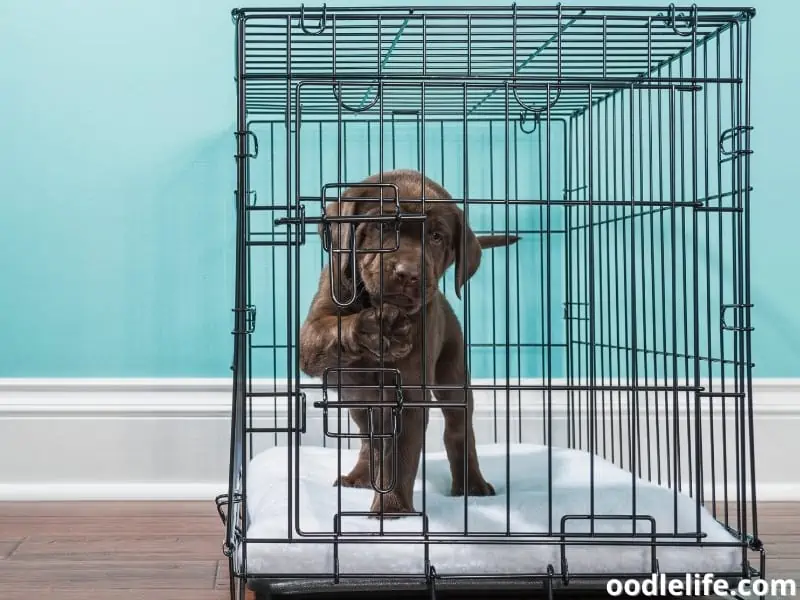How Long Can a Dog Be in a Crate?
Crate training is a well-known solution for keeping a dog safe and contained during the night and when the owner is away.
Training your dog to stay in a crate for some time has its benefits but the question is, how long can a dog be in a crate?

The recommended crate time for dogs is 30-60 minutes for puppies 8-10 weeks old, 1-3 hours for pups 11-14 weeks old, 3-4 hours for pups aged 15-16 weeks old, 4-5 hours for dogs 17 weeks and above, and 8 hours maximum suggested crate time for a full grown adult, healthy dogs.
Concerns Around Crating Dogs
Safety is the primary concern regarding crate training. However, the suggested number of time dogs spend in a crate also calls for major concern because they’re naturally social animals. Putting them in a limited space can trigger irritation and aggression and complicate current health conditions.

Check the table below for a guide to how long a dog can be in a crate:
| Age of the Dog | Maximum Crate Time |
| 8-10 weeks | 30-60 minutes |
| 11-14 weeks | 1-3 hours |
| 15-16 weeks | 3-4 hours |
| 17 weeks and above | 4-5 hours |
| Adult dogs (healthy) | 8 hours |
Puppies
There are different factors taken into consideration when putting a puppy in a crate. Puppies are fragile and sensitive. Just like newborn babies, they require loads of attention and extra parenting care.
Thus putting them in a crate alone is not recommended.
However, in exceptional cases and when the need arises or if you have no other choice, putting them in a crate can be an option, but for a limited time only. Here are some reasons why:
1. Puppies Need Special Care
Puppies are at the stage of exploring, learning from experience, and dependent on their fur parents on some levels. They need extra care, lots of attention, loads of love, adequate playtime, plenty of chew toys to aid their teething and chewing habits, a sufficient amount of discipline, and several boundaries, to mention a few.

Caging them in a crate will limit their access to their primary needs. This limitation will agitate them, disrupt their regular daily routine, or even put their safety at risk. For some reason, crate training can be helpful for discipline, weaning, and teaching them independence or having them get used to a bit of alone time.
But again, it works just fine at a limited time, in a supervised environment, and under the close guidance of fur parents.
2. Different Recommendations From Authority Organizations
Organizations designed to look after the welfare of animals has set different parameters on how long can a dog be in a crate. You can use these standards to help you identify the healthy number of hours to keep them in a crate.

The Humane Society of the United States suggests that puppies below six (6) months old should only be caged in a crate for a maximum of 3-4 hours at a time.
The SPCA, or Royal New Zealand Society for the Prevention of Cruelty to Animals Incorporated, recommends a crate time of 2-3 hours maximum for pups below six (6) months old.
The SPCA, or San Francisco Society for the Prevention of Cruelty to Animals, recommends a stricter time in a crate and states that dogs, regardless of age and health condition, should never be left inside a crate for more than 3-4 hours, other than bedtime. The crate time guideline is as follows:
| Age of the Dog | Maximum Crate Time |
| 8-10 weeks | 1 hour |
| 11-12 weeks | 2 hours |
| 13-16 weeks | 3 hours |
| 20 weeks and above | 4 hours |
3. Pups Have Small Bladders and Minimal Bowel Control
Puppies have small bladders, which is why they can’t hold their pee very long. They also have minimal bowel control and need to poop every few hours. Pups and small-breed dogs (due to their small body size) metabolize food and drinks more quickly than large-breed ones.

That’s why placing them in a crate for several hours could lead to a messy disaster that could subject your pups to toxic consequences.
The general rule of thumb is that the age of the pups (in months) is the same number of hours they can hold their bladder. Quite confusing? For instance, 2-month-old pups can hold their bladders for a maximum of 2 hours at a time.
4. Puppies Are Social Animals
Pups are social animals and need constant socialization. They are naturally inquisitive of their environment and are still learning their way through the house. Isolating them in a limited space may trigger anxiety, fear, and boredom. These negative emotions can lead to aggression.

This is why puppies need attention and patience when training them. Moreover, they naturally want to move around the house to learn fast and get used to their environment.
5. Pups Need Physical and Mental Stimulation
Have you ever wondered why your pups are playful? It’s because they have lots of stored energy that they need to use up and burn through physical activities. That’s also why they love roaming around, running back and forth, and are restless most of the time.

It’s normal and part of their growing up process.
They are a ball of energy for a reason. The stored energy in them is necessary to keep them moving and physically active, which helps their muscle and bone growth. The same idea applies to their mental health.
They are curious and learn from experience.
Having the freedom to move aids in their mental and physical growth. They are naturally intelligent animals. However, they also need your help to harness their intelligence.
So let them learn and don’t bind them into a limited space for an extended period like crates.
Adult Dogs
You can place your full-grown adult dog in a crate for eight hours per day, given that your dog is healthy and crate trained. They can use their crate time to sleep and rest. However, keeping them inside a crate for more than eight hours may lead to accidents and irreversible consequences.

Adult dogs need socialization, regular physical activities, and elimination. Keeping them in a crate for more than the suggested time can lead to an unhygienic mess as they can’t hold their bladder and bowel for too long. It can also trigger anxiety and fear, which could eventually lead to aggression.
Furthermore, regularly keeping your dogs in a crate for an extended period can cause serious health problems such as dehydration, muscle weakening, bone deterioration, joint problems, and mental issues.
Senior Dogs
Senior dogs cannot stay inside a crate for long. If a healthy adult dog can stay 8 hours inside a crate, senior dogs should be given a threshold with little crate time. Yes, they can use crates, but for a shorter time than adult dogs and longer periods than puppies.

Why?
Most senior dogs experience health issues due to old age. They need special care and extra attention to tend to their needs and give them security and lots of love. Additionally, they need frequent pee and poo break, whether due to incontinence and bowel issues or just plain old age.
Frequently Asked Questions
Here are some of the most commonly asked questions regarding crate training:
Why should you crate train your dog?
Crate training aims to help discipline dogs, specifically potty training, and teach them the proper place to sleep and rest at night. It also prevents them from roaming around the house at night, especially if they chew things such as shoes and carpets.

How long does it take to crate train a dog?
The general rule is that dogs pick up the routine of sleeping in their crate at night approximately after two years since you started the training. Two years is also enough time for your dog to mature and learn from this habit. But there’s no definitive time, just an approximation because dogs’ learning process varies.

Wrap-Up
There’s no definitive answer about how long a dog can be in a crate because dogs vary depending on breed, training, age, health conditions, and environment. Different guides are available to help you get an idea of how long they can be in a crate depending on age.
These recommendations only serve as a guide but not a solid rule to follow. Exemptions are applicable, especially since each dog needs unique and personally tailored care. However, there should be a balance between discipline and safety.